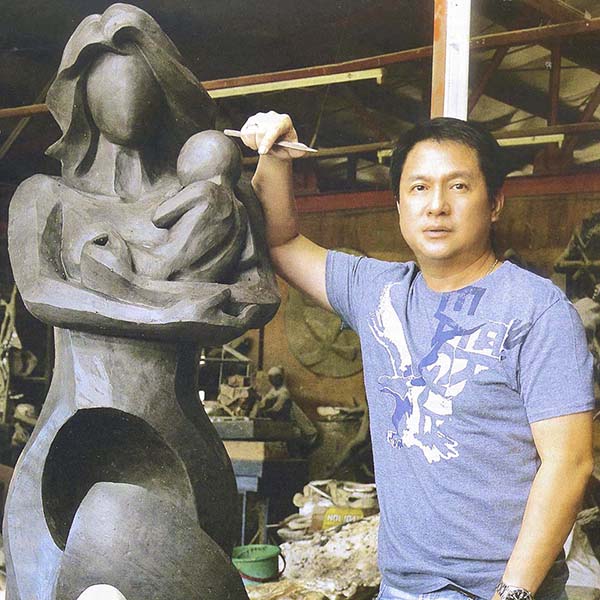First published in Tulay Fortnightly, Chinese-Filipino Digest,
vol. 17, no. 24, 19 May – 15 June 2015 issue, pp. 15-16.
I wish for my artwork to genuinely represent the dreams and aspirations of people. I want it not only to become an aesthetic presence, but rather transcend into a positive visual message to inspire the world. — Eusebio Chua
Born on Jan. 1, 1963 in Quezon City, Eusebio ‘Seb’ Chua Jr. (蔡敦榮), is the eldest son of Eusebio Tiu Chua and Ana Ang Chua. His father worked as a chemist, while his mother taught Chinese cultural dance and songs to children.
Perhaps it was his mom’s artistic genes and passion for the arts that influenced him; he took up Fine Arts Studies at the University of Sto. Tomas.
While in college, he discovered his interest centered on sculpture when he was invited to join a group exhibit. The experience set him on the path to become a full-fledged artist.
“I still couldn’t believe it. My entries sold out during the first week of the show!” he says.
That experience convinced him to be more serious about sculpture. He unhesitatingly credits artist Fred Baldemor, whose works he began collecting in college, as a major influence in his work. He also considers sculptor and painter Merlito “Noy” Gepte friend and mentor. Gepte recently won the grand prize for sculpture in the Metrobank Art and Design Excellence competition.
Baldemor, Chua says, “is my maestro of inspiration. But he has a different style. Eventually, he became my kumpare.”
“My art practices were mostly due to self study and experimentation,” he says. “But I am lucky to be guided” by both these artists.
Beyond sculpture, Chua also paints.
“I started painting by doing small-sized works, which are all very modern in both figurative and abstract styles. Unlike sculpting, I derive a different kind of fulfilment every time I play around with colors and strokes. Sculpting is more about forms and themes rather than the vibrancy of hues and tones.”
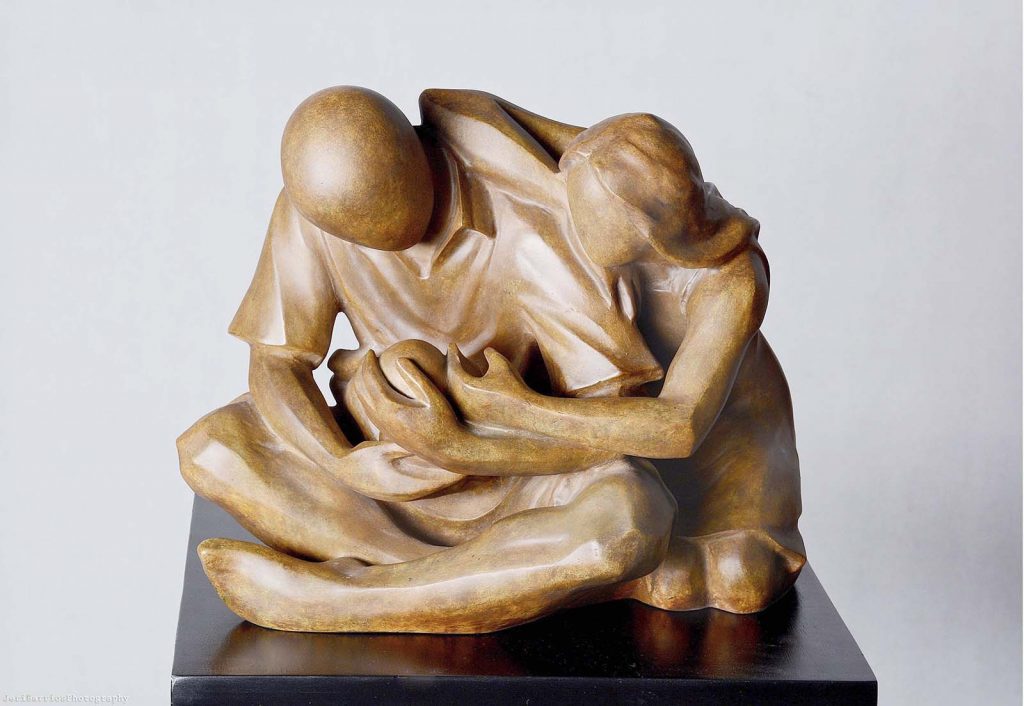
He gains inspiration from National Artist Jose Joya’s work, and considers his role model Mauro Malang Santos – Malang in art circles – a prominent and award-winning cartoonist, illustrator, and fine arts painter.
“Joya’s powerful strokes and colors are intense!”
As for Malang’s work, “I like his optimistic themes and colors aside from how he composes his works,” he says. While in high school at Xavier School in Greenhills, San Juan, the young Tsinoy used to visit Malang’s Marisan art gallery along West Avenue in Quezon City.
“I guess there is a portion of Chinese influence instilled in my abstract paintings. I have always been fascinated with the contemporary art of eastern calligraphy. The fluid and bold brush strokes are so powerful, and an aesthetic link to this style may be evident in some of my abstract paintings.”
Today, as a mature artist, Chua has produced works that he is proud of.
“I don’t remember what was my first ever attempt but SINAG (2005), a very modern-abstract figure of a man covering his face from the brightness of the sun, is the first piece I’m proud of,” he says.
Like any other beginner artist, he struggled with the medium. “I wanted to work in bronze but the process was too complicated and costly,” he says.
Chua went to the United States to learn the cold bronze casting process. Most of his current works are cast with marble as the base material then coated in bronze using the cold casting process.
“The work I am most proud of is entitled Mother’s Love, a limited edition sculpture as part of the fund raising project of UNICEF for the benefit of the children.”
Other pieces he is proud of are The Guardian and Silent Companion, both life-size sculptures commissioned by the Philippine Animal Welfare Society.
Both are permanently displayed at SM Mall of Asia in Pasay City and at the Eastwood Center in Quezon City.
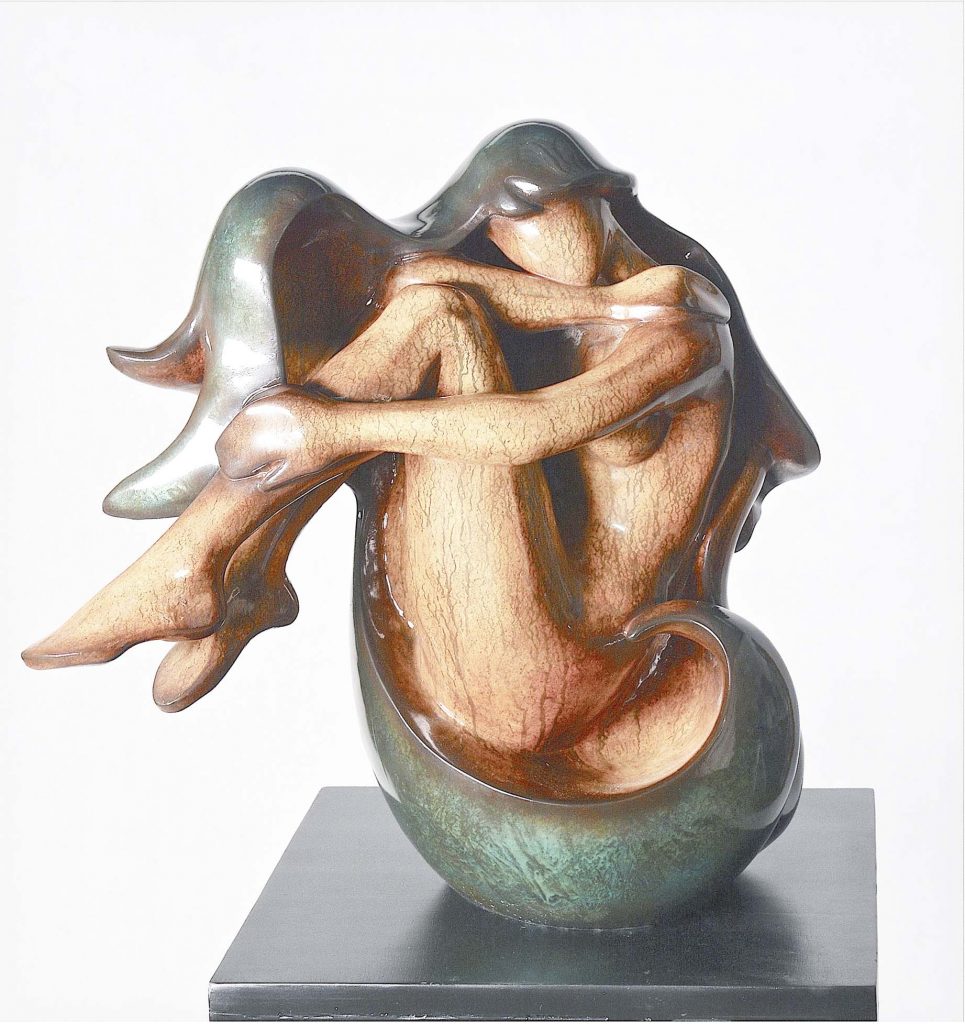
Tsinoy roots
The firstborn in a Tsinoy family, Chua subscribes to his father’s work edict: “Work is a responsibility.”
Because of this, he had qualms about pursuing the arts when he was young. “It was tough to earn a living if you’re an artist. Being the eldest, I needed to help manage our family business. My brothers were very young so it was my obligation to help.”
This idealism, however, did not discourage him. “Art is my passion. Though I started late, I have no regrets about it.”
Today, he is president of the family business which makes car seats and components to supply major car assemblers like Mitsubishi Motors Philippines Corp. and Columbian Motors Corp.
However, he has taken on an advisor role. His two younger brothers actively manage the business so well that he needs to visit the factory only occasionally to check on the general workings.
“Most of the time, they call me for advice, or if there is a need to meet with visitors or clients. That’s why I can afford to practice my art almost full time now.”
As well, he owns the Art Asia Gallery in SM Megamall, Mandaluyong City.
Gallery ownership was never a plan. After his first group exhibit, his brother in-law Maximo Chan dared him to open one.
“We were talking to some gallery owners in SM Megamall at one time and were informed that this certain gallery was moving out of the area, so we decided to meet with SM’s leasing manager to learn more about the lease contract and their policies. Before we knew it, our group got the lease for Art Asia’s location.”
His grandfather, Santos Chua Haw Ko (蔡孝固), was a migrant from Xiamen and past president of the Federation of Filipino-Chinese Chambers of Commerce and Industry Inc. from 1962 to 1966.
“He used to talk often about how hard it was when they began living here in the Philippines. His business (sold) double-decker beds to local markets, which was a modest success.”
The company Philippine Bed Factory in Quezon City is now Philippine Bed & Furniture Manufacturing. Corp.
Being Chinese meant observing many customs and traditions. But the younger Chuas also had certain freedoms, such as choosing their religious beliefs.
Chua speaks Hokkien and a little Mandarin.
“One Chinese custom that we believe in and highly value is obeying the father’s advice,” says Chua.
This respect for his father delayed his venture into the arts.
“My father (said) to focus on business first and that art should only be a hobby and not something that should take so much time,” he muses.
“To this day, he hasn’t figured it out and claims that if one can make money, then he can just collect art. That’s what I did. I collected art works before I turned into an artist myself.
“I don’t think being Chinese restricts one’s tendency to be an artist. Ang Kiu Kok was Tsinoy and he was one of our most respected national artists.”
He quickly adds that though his heart is Filipino, being Tsinoy has its advantages.
“My Chinese attributes have been an advantage in many unforeseen ways. I was trained as a businessman, thus I adopt and proactively seek solutions to my art-making in the most innovative ways I can imagine.”
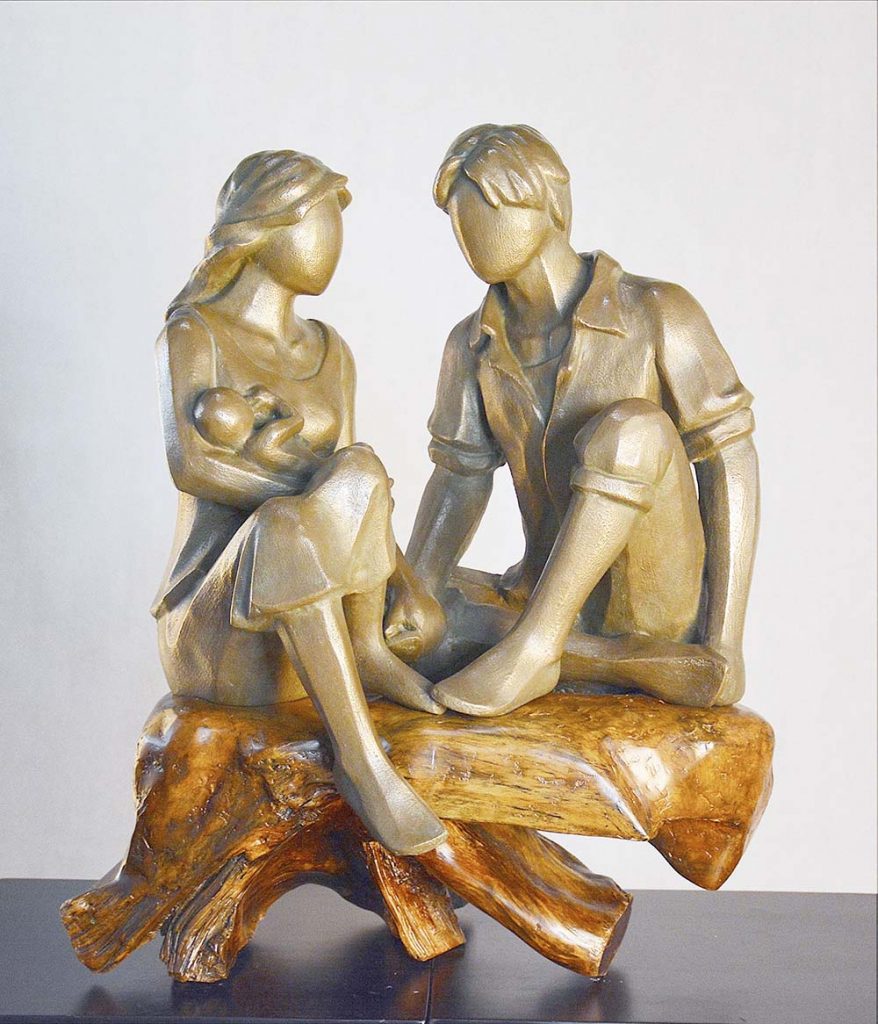
Family
Chua is a dedicated father to his sons, Kylo, Erick, and Kevin.
“My family is my inspiration for my art. Karen, my wife, though not an artist, advises me in the many facets of my art collecting. Kylo, my eldest son, is also an abstract sculptor, as well as an accomplished graduate gemologist. Erick is the marketing expert in the family. He has a startup business, almost a year old now. My youngest son Kevin is in high school and an avid fan of traditional Japanese culture.”
Among his kids, it is Kylo – his namesake Eusebio Ehron Kylo Yu Chua III – who loves sculpture. He started creating small sculptures in limited edition when he was at the Ateneo de Manila High School.
“He would frequently join annual Rotary group art exhibits at the Mandarin Hotel and occasionally display some of his works at the Art Asia Gallery. Later on, he developed a deep interest in jewelry art and gemstones.
This growing passion allowed him to graduate top of his class at the prestigious Gemological Institute of America (GIA). He often imagines a beautiful merge between sculptural art and natural gemstones.”
Chua says he did not directly influence Kylo in sculpture.
“I did not ask him to learn about sculpture. It just came naturally to him to create 3-D art, probably from watching me work. Like me, he first became interested in abstract sculpting during his college years.”
It is easy to make comparisons but the father says he and his son do not compete. “We have very distinct styles.”
In fact, Kylo often joked and bragged about his works. “Dad, my white glossy top coating is off limits to you.”
To which Chua would counter, “Kylo, this bronze finish is exclusively mine.”
Both father and son have shared and exhibited their works in galleries, and some on display at Art Asia Gallery.
“I’m very proud of Kylo. However, he has decided to traverse a new path as a gemologist and considers himself now a part-time artist. Being an artist especially here in the Philippines is not easy. There are too many good artists and just a handful of serious collectors. Be prepared to compete, work super hard to create quality pieces and to price them modestly when just starting,” he says. “Gain the respect of your peers and fellow artists by joining various art exhibits and competitions, you’ll eventually find success in this fulfilling industry.”
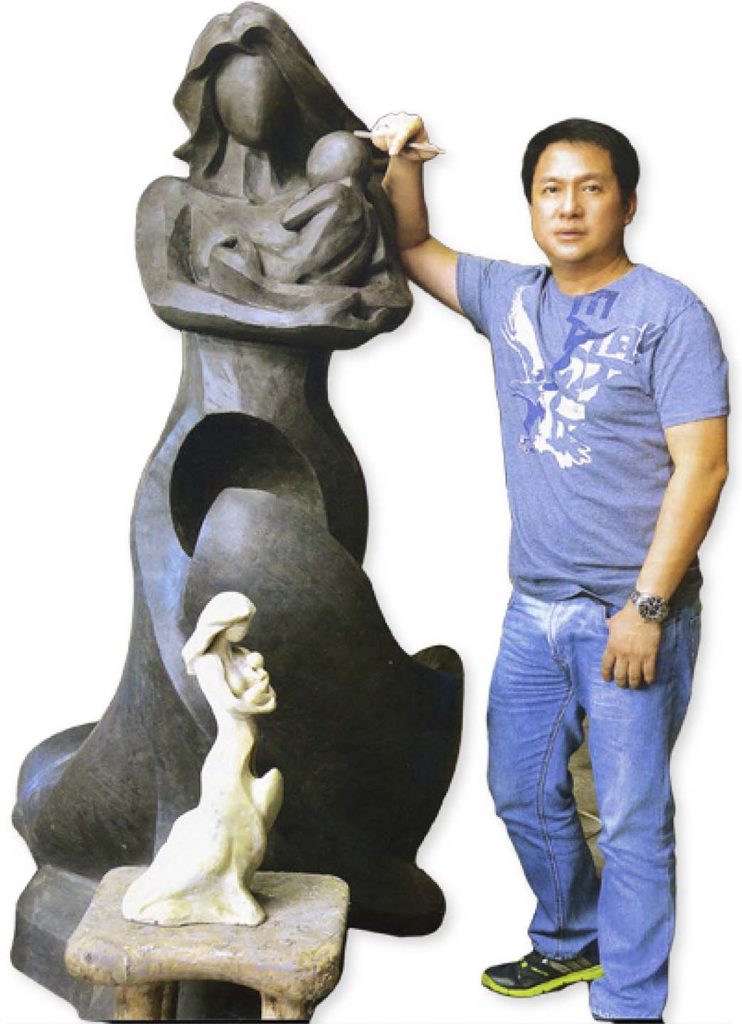
Backing up these words are the recognition and awards he has received. These include Finalist in Metrobank, 2012; second prize in GSIS Competition, 2011; third prize in Art Association of the Philippines Art Competiton, 2009; and Honorable Mention Awardee in AAP Art Competitions, 2006 and 2007.
